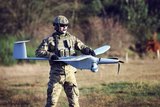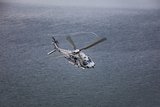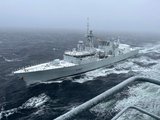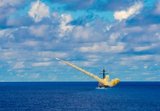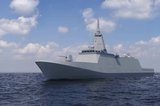CMV-22B Ospreys deploy to Indo-Pacific
A Bell-Boeing CMV-22 Osprey aboard the USS Carl Vinson in the Western Pacific. (Photo: USN/Mass Communication Specialist 3rd Class Erin Zorich)
The USN’s second operational deployment of the Bell-Boeing CMV-22B Osprey tiltrotor in the carrier onboard delivery (COD) mission is underway, USMC Col Brian Taylor of the V-22 Osprey Joint Program Office said on 4 April during the 2022 Navy League meeting in Washington DC.
This follows the first CMV-22B operational deployment aboard the carrier USS Carl Vinson, and the USN announcing on 18 February that the aircraft achieved IOC.
The current CMV-22 deployment to the Indo-Pacific Command Area Of Responsibility (INDOPACOM AOR), is on the carrier USS Abraham Lincoln, which, like the Carl Vinson, had deployed carrying
Already have an account? Log in
Want to keep reading this article?
More from Naval Warfare
-
![Future Canadian Continental Defence Corvette will provide “Halifax-equivalent capabilities”]()
Future Canadian Continental Defence Corvette will provide “Halifax-equivalent capabilities”
Although the CDC project is still in its early stages, the Canadian Department of National Defence already has some requirements for the future platforms.
-
![US Navy to acquire micro-uncrewed underwater vehicles for ISR and coastal data collection]()
US Navy to acquire micro-uncrewed underwater vehicles for ISR and coastal data collection
The Naval Supply Systems Command is seeking authorised resellers of JaiaBot uncrewed underwater vehicles and multivehicle pods. The platforms will support undergraduate education at the US Naval Academy.
-
![NATO tests use of “undetectable, jam-proof” laser communication in maritime scenarios]()
NATO tests use of “undetectable, jam-proof” laser communication in maritime scenarios
As part of its effort to better prepare its capabilities for operations in contested and congested scenarios, NATO evaluated a Lithuanian ship-to-ship terminal designed to not be susceptible to enemy interference.
-
![US Navy advances with the Harpoon Service Life Extension Programme]()
US Navy advances with the Harpoon Service Life Extension Programme
The US Navy plans to improve Harpoon’s anti-ship and land attack capabilities by equipping the missiles with sensors and technologies required for succeeding in future battlespace.
-
![Future of the Canadian Patrol Submarine Project is still unclear]()
Future of the Canadian Patrol Submarine Project is still unclear
The Canadian government remains tight-lipped on the timeline and funding required for the next steps of its Canadian Submarine Patrol Project, which should offer improved capabilities for the country’s navy.
-
![Mitsubishi eyes future with Australia’s Mogami selection]()
Mitsubishi eyes future with Australia’s Mogami selection
With Australia’s selection of the Mogami-class for Project Sea 3000, Mitsubishi is investigating local production in the next decade as potential export opportunities emerge.








